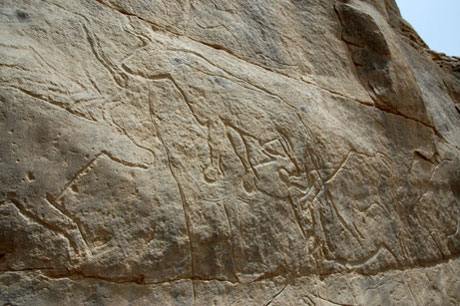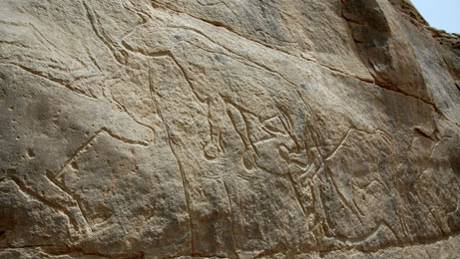Egypt's Oldest Known Art Identified, Is 15,000 Years Old
Source: news.nationalgeographic.com
 Etchings at Qurta, located about 400 miles (640 kilometers) south of Cairo, Egypt, depict a now extinct species of wild cow. The rediscovered artwork—similar in look and age to iconic paintings in Spain and France—pushes "Egyptian art, religion, and culture back to a much earlier time," archaeologists say. Photographs courtesy Dirk Huyge |
Rock face drawings and etchings recently rediscovered in southern Egypt are similar in age and style to the iconic Stone Age cave paintings in Lascaux, France, and Altamira, Spain, archaeologists say.
"It is not at all an exaggeration to call it 'Lascaux on the Nile,'" said expedition leader Dirk Huyge, curator of the Egyptian Collection at the Royal Museums of Art and History in Brussels, Belgium.
"The style is riveting," added Salima Ikram of the American University in Cairo, who was part of Huyge's team.
The art is "unlike anything seen elsewhere in Egypt," he said.
The engravings—estimated to be about 15,000 years old—were chiseled into several sandstone cliff faces at the village of Qurta, about 400 miles (640 kilometers) south of Cairo (Egypt map).
Of the more than 160 figures found so far, most depict wild bulls. The biggest is nearly six feet (two meters) wide.
The drawings "push Egyptian art, religion, and culture back to a much earlier time," Ikram said.
The team's findings will be published in the September issue of the British quarterly journal Antiquity.
Before Its Time
The Qurta art has now twice been uncovered by modern researchers.
Some of the engravings were first found in 1962 by a group from the University of Toronto, Canada.
The leader of that expedition, Philip Smith, made the then novel suggestion that the figures were from the Paleolithic age—the Stone Age period from about 2.5 million years ago to about 10,000 years ago—in a 1964 article in Archaeology magazine.
But he abandoned the hypothesis in later years.
"The Paleolithic experts told them, It's absolutely crazy—Europe is the cradle of art," Huyge, the leader of the new expedition, said. "And they backed off the idea.
"They must have accepted the fact that that nobody wanted to believe them, but they were right."
Discoveries of Paleolithic art in southern Africa and Australia since then have paved the way for the scientific community to accept what Smith first diffidently suggested, Huyge said.
Neither Smith, who has retired, nor his assistant on that expedition, Morgan Tamplin, now a professor emeritus at Trent University in Canada, could be reached for comment.
Thinking Alike
Huyge's March 2007 expedition strengthened the findings that Smith had discarded. The team found several additional panels of artwork over a 1-mile-long (1.66-kilometer-long) stretch of 230-foot-tall (70-meter-tall) sandstone cliffs.
There is "little doubt" the engravings are 15,000-years-old, Huyge said. They depict a now extinct species of wild cow whose horns have been recovered from Paleolithic settlements nearby.
The drawings would be examined for lichens and organic grime called "varnish rind" that could be carbon dated or subjected to another process known as uranium series dating, Huyge added. Because the rocks are inorganic, they cannot be dated directly using these methods.
In the meantime, the finding has raised a big question: How were people in Western Europe and southern Egypt producing almost identical artwork at the same time?
While the caves at Lascaux are best known for their painted images of bulls and cows, that artwork is actually outnumbered by stone engravings. And the Lascaux engravings are virtually identical to those in Qurta, Huyge pointed out.
"I'm not suggesting that the art in the caves of Lascaux was made by Egyptians or that [European] people were in Egypt," he said.
"The art is so similar that it reflects a similar mentality, a similar stage of development," he added. "When people are confronted with similar conditions, this will automatically lead to a similar kind of thinking, a similar creativity."
Now the archaeologists are on the hunt for additional—and potentially older—artwork.
"The rock art must be part of an evolution," Huyge said. "There must be older art in Egypt, if we can find it. I think open-air sites like Qurta will be found all over North Africa."
Article from: http://news.nationalgeographic.com/news/
2007/07/070711-egypt-artwork.html






















